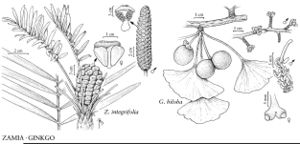Difference between revisions of "Zamiaceae"
FNA>Volume Importer |
imported>Volume Importer |
||
| (2 intermediate revisions by 2 users not shown) | |||
| Line 19: | Line 19: | ||
|discussion=<p>Genera 9, species ca. 100 (1 genus, 1 species in the flora).</p> | |discussion=<p>Genera 9, species ca. 100 (1 genus, 1 species in the flora).</p> | ||
|tables= | |tables= | ||
| − | |references= | + | |references={{Treatment/Reference |
| + | |id=candolle1868a | ||
| + | |text=Candolle, A. L. P. de. 1868. Cycadaceae. In: A. P. de Candolle and A. L. P. de Candolle, eds. 1823--1873. Prodromus Systematis Naturalis Regni Vegetabilis.... Paris etc. Vol. 16, part 2, pp. 522--547. | ||
| + | }}{{Treatment/Reference | ||
| + | |id=johnson1959a | ||
| + | |text=Johnson, L. A. S. 1959. The families of cycads and the Zamiaceae of Australia. Proc. Linn. Soc. New South Wales 84: 64--117. | ||
| + | }}{{Treatment/Reference | ||
| + | |id=schuster1932a | ||
| + | |text=Schuster, J. 1932. Cycadaceae. In: H. G. A. Engler, ed. 1900--1953. Das Pflanzenreich.... Berlin. Vol. 99[IV,1], pp. l--168. | ||
| + | }} | ||
}}<!-- | }}<!-- | ||
| Line 36: | Line 45: | ||
|illustration copyright=Flora of North America Association | |illustration copyright=Flora of North America Association | ||
|distribution=Primarily tropical to warm temperate regions;North Americ;Central America;South America;Africa;Australia. | |distribution=Primarily tropical to warm temperate regions;North Americ;Central America;South America;Africa;Australia. | ||
| − | |reference= | + | |reference=candolle1868a;johnson1959a;schuster1932a |
|publication title= | |publication title= | ||
|publication year= | |publication year= | ||
|special status= | |special status= | ||
| − | |source xml=https:// | + | |source xml=https://bitbucket.org/aafc-mbb/fna-data-curation/src/2e0870ddd59836b60bcf96646a41e87ea5a5943a/coarse_grained_fna_xml/V2/V2_662.xml |
}}<!-- | }}<!-- | ||
-->[[Category:Treatment]] | -->[[Category:Treatment]] | ||
Latest revision as of 20:24, 5 November 2020
Plants superficially palmlike or fernlike, perennial, evergreen, dioecious. Stems subterranean with exposed apex or aboveground, fleshy, stout, cylindric, simple or irregularly branched. Roots with small secondary roots; coral-like roots developing at base of stem at or below soil surface. Leaves pinnately compound, spirally clustered at stem apex, leathery, petiole and rachis unarmed [with stout spines]; leaflets entire or dentate [spinose], venation dichotomous [netted]; resin canals absent. Cones axillary, appearing terminal, short-peduncled [sessile], disintegrating at maturity; sporophylls densely crowded, spirally arranged, often covered with indument. Pollen cones soon shed, generally smaller and more numerous than seed cones; sporophylls bearing many crowded, small microsporangia (pollen sacs) adaxially; pollen spheric, not winged. Seed cones persistent for a year or more, 1(–2) per plant, nearly globose to ovoid, tapering sharply or blunt at apex; sporophylls peltate, thickened and laterally expanded distally, bearing 2(–3) ovules. Seeds angular, inner coat hardened, outer coat fleshy, often brightly colored; cotyledons 2.
Distribution
Primarily tropical to warm temperate regions, North Americ, Central America, South America, Africa, Australia.
Discussion
Genera 9, species ca. 100 (1 genus, 1 species in the flora).
